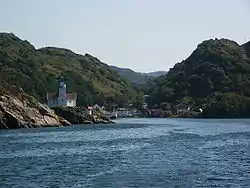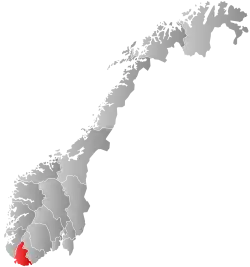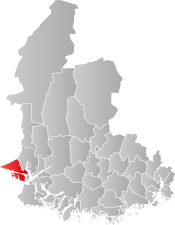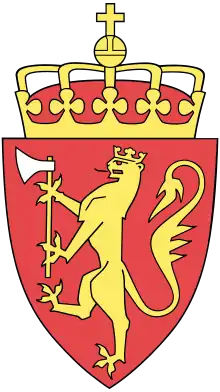Hidra, Vest-Agder
Hidra is a former municipality that was located in the old Vest-Agder county in Norway. The 90-square-kilometre (35 sq mi) municipality existed from 1893 until its dissolution in 1965. It encompassed the islands and southern coastal part of the present-day municipality of Flekkefjord in what is now Agder county. The municipality included the islands of Hidra and Andabeløya as well as 56 other islands, plus the mainland coast from Abelsnes to the river Sira. The administrative centre was the village of Kirkehavn where Hidra Church is located.[1]
Hidra herred
Hitterø herred | |
|---|---|
 The village of Kirkehavn on Hidra | |
 Vest-Agder within Norway | |
 Hidra within Vest-Agder | |
| Coordinates: 58°13′15″N 06°34′45″E | |
| Country | Norway |
| County | Vest-Agder |
| District | Lister |
| Established | 8 Oct 1893 |
| Disestablished | 1 Jan 1965 |
| Administrative centre | Kirkehavn |
| Area | |
| • Total | 90 km2 (30 sq mi) |
| *Area at municipal dissolution. | |
| Population (1965) | |
| • Total | 1,277 |
| • Density | 14/km2 (37/sq mi) |
| Time zone | UTC+01:00 (CET) |
| • Summer (DST) | UTC+02:00 (CEST) |
| ISO 3166 code | NO-1042 |
| Preceded by | Nes og Hitterø in 1893 |
| Succeeded by | Flekkefjord in 1965 |
Hidra was home to Olav Omland (1909–1998), a landscape and coastal painter. He was also a poet and songwriter, and composed the song about Hidra "Hidrasangen". Hidra was also home to the eccentric personality and artist Tatjana Lars Kristian Guldbrandsen.
Name
The Old Norse form of the name was Hitr. The name is probably derived from a word with the meaning "split" or "cleft" (referring to the fact that the island is almost split in two by the Rasvåg fjord).[1][2] Prior to 1918, the name was spelled Hitterø.
History
The parish of Nes og Hitterø was established as a municipality on 1 January 1838 (see formannskapsdistrikt law). However, on 8 October 1893, this municipality was split into two municipalities: Hitterø (population: 2,075) and Nes (population: 1,704). During the 1960s, there were many municipal mergers across Norway due to the work of the Schei Committee. On 1 January 1965, Hidra municipality (formerly called Hitterø) was merged with the municipalities of Nes, Gyland, most of Bakke, and the town of Flekkefjord to form the new municipality of Flekkefjord. Prior to the merger, Hidra had a population of 1,277.[3]
Government
All municipalities in Norway, including Hidra, are responsible for primary education (through 10th grade), outpatient health services, senior citizen services, unemployment and other social services, zoning, economic development, and municipal roads. The municipality was governed by a municipal council of elected representatives, which in turn elected a mayor.[4]
Municipal council
The municipal council (Herredsstyre) of Hidra was made up of representatives that were elected to four year terms. The party breakdown of the final municipal council was as follows:
| Party Name (in Norwegian) | Number of representatives | |
|---|---|---|
| Labour Party (Arbeiderpartiet) | 2 | |
| Conservative Party (Høyre) | 2 | |
| Christian Democratic Party (Kristelig Folkeparti) | 3 | |
| Liberal Party (Venstre) | 6 | |
| Total number of members: | 13 | |
| Party Name (in Norwegian) | Number of representatives | |
|---|---|---|
| Local List(s) (Lokale lister) | 13 | |
| Total number of members: | 13 | |
| Party Name (in Norwegian) | Number of representatives | |
|---|---|---|
| Local List(s) (Lokale lister) | 12 | |
| Total number of members: | 12 | |
| Party Name (in Norwegian) | Number of representatives | |
|---|---|---|
| Labour Party (Arbeiderpartiet) | 2 | |
| Local List(s) (Lokale lister) | 10 | |
| Total number of members: | 12 | |
| Party Name (in Norwegian) | Number of representatives | |
|---|---|---|
| Local List(s) (Lokale lister) | 12 | |
| Total number of members: | 12 | |
| Party Name (in Norwegian) | Number of representatives | |
|---|---|---|
| Labour Party (Arbeiderpartiet) | 2 | |
| Joint List(s) of Non-Socialist Parties (Borgerlige Felleslister) | 9 | |
| Local List(s) (Lokale lister) | 1 | |
| Total number of members: | 12 | |
References
- "Hidra". Store norske leksikon (in Norwegian). Retrieved 29 October 2009.
- Rygh, Oluf (1912). Norske gaardnavne: Lister og Mandals amt (in Norwegian) (9 ed.). Kristiania, Norge: W. C. Fabritius & sønners bogtrikkeri. p. 303.
- Jukvam, Dag (1999). "Historisk oversikt over endringer i kommune- og fylkesinndelingen" (PDF) (in Norwegian). Statistisk sentralbyrå.
- Hansen, Tore, ed. (12 May 2016). "kommunestyre". Store norske leksikon (in Norwegian). Kunnskapsforlaget. Retrieved 21 November 2020.
- "Kommunevalgene og Ordførervalgene 1959" (PDF) (in Norwegian). Oslo: Statistisk sentralbyrå. 1960. Retrieved 21 November 2020.
- "Kommunevalgene og Ordførervalgene 1955" (PDF) (in Norwegian). Oslo: Statistisk sentralbyrå. 1957. Retrieved 21 November 2020.
- "Kommunevalgene og Ordførervalgene 1951" (PDF) (in Norwegian). Oslo: Statistisk sentralbyrå. 1952. Retrieved 21 November 2020.
- "Kommunevalgene og Ordførervalgene 1947" (PDF) (in Norwegian). Oslo: Statistisk sentralbyrå. 1948. Retrieved 21 November 2020.
- "Kommunevalgene og Ordførervalgene 1945" (PDF) (in Norwegian). Oslo: Statistisk sentralbyrå. 1947. Retrieved 21 November 2020.
- "Kommunevalgene og Ordførervalgene 1937" (PDF) (in Norwegian). Oslo: Statistisk sentralbyrå. 1938. Retrieved 21 November 2020.

